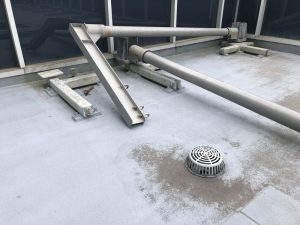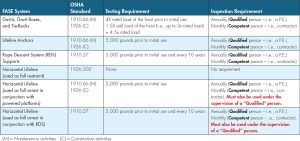Many buildings and other structures include structural components that are parts of suspended scaffold and rope descent systems used to gain physical access to elevated areas. The Occupational Safety and Health Administration (OSHA) federal regulations include many provisions related to the design and evaluation of suspended scaffold systems and related items such as equipment tieback and lifeline support anchorages. While many of the relevant OSHA provisions are clear and consistent, several important structural requirements are either unclear, inconsistent with one another, or both. However, the International Building Code (IBC) is very clear on the structural requirements for the design and load testing of façade access support equipment (FASE). The different types of FASE consist of davit and davit bases (Figure 1) and fall arrest anchors (Figure 2). The purpose of the FASE is to support the suspended system, including powered platforms (Figure 3), rope descent systems (RDS) (Figure 4), and lifelines. This article provides specific commentary concerning the OSHA and IBC structural provisions regarding FASE design and load testing and presents proper approaches to load testing of FASE.
Standards
OSHA operates under a federal mandate to regulate workplace safety and develop minimum safety standards nationwide; all applicable FASE operations fall under their jurisdiction. Load testing requirements are also specified in the IBC. Table 1 summarizes the key OSHA standards that most likely apply to most FASE-related installations.
Note that OSHA requires that FASE equipment be used under the supervision of a Qualified person, i.e., a licensed Structural Engineer, based on OSHA’s definition. This requirement has practical difficulties because FASE users would have to essentially hire a Structural Engineer to be present on-site with them the entire time the FASE is being used.

The IBC started incorporating façade access support equipment design and load testing requirements in its 2015 version. Section 1607.9.3 indicates that façade access equipment used to support hoists must be designed for the larger of the hoist’s stall load (allowed to be a maximum of 3 times the rated load) or 2.5 times the rated load of the hoist. In other words, from a structural engineering standpoint, the service load for FASE design is 3,000 pounds for a 1,000-pound rated hoist. This is in addition to other applicable live loads. Also, the design should include a live load factor of 1.6. For example, if the hoist rated load is 1,000 pounds, the design load should be 3 x 1,000 x 1.6 = 4,800 pounds. The design load for lifeline anchorage is 3,100 pounds times a live load factor of 1.6 for each attachment in each direction the fall arrest load may be applied. Also, Section 1708.3.2 of the IBC and the American Society of Civil Engineers (ASCE) Facade Access Equipment: Structural Design, Evaluation, and Testing guideline indicate that test loads shall be full factored design loads. Table 2 summarizes the FASE design and load testing requirements by OSHA and the IBC 2015.
Load Testing
Since July 23, 1990, OSHA has required that all FASE components be verified by load testing prior to initial use. OSHA does not provide specific test requirements, but the load testing is valid only by applying a load that demonstrates conformance to minimum strength requirements (a stated OSHA testing objective). Therefore, load test demands must, at the very least, reflect the equivalent of full factored loads. This requirement is clearly indicated in the IBC.
Also, suppose proof testing to factored loads is performed. In that case, testing a sample of the total FASE population will not lead to reliable statistical inferences regarding the strengths of the untested FASE elements. For example, testing 8 out of 10 davit bases to factored loads provides only an 80 percent degree of confidence that the remaining bases had adequate strength, which is not acceptable for structural elements. The reasons are numerous: the connections of the FASE component to the building structure can vary, the building structure configuration can also vary, there could be hidden construction deficiencies that affect the behavior of some but not all FASE components, there could be distress of steel components of some of the FASE components due to corrosion from water infiltration, etc. Even if all the FASE components are exactly the same, the results of testing a sample of the populations do not mean the rest of the populations will achieve the same result.
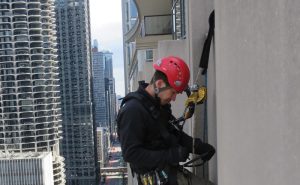
In the cases where full load testing is not feasible to perform, additional measures could be implemented, including the following:
- Proof testing FASE elements to loads beyond minimum factored loads: Testing a sample of elements to higher loads can provide high levels of confidence that untested elements have sufficient strength. However, such test programs must be carefully developed and consider the degree of similarity between tested and untested elements and the minimum acceptable degree of confidence.
- Perform thorough visual inspections and structural analysis of untested FASE elements: This is needed to ensure the tested elements adequately represent the critical components of the untested elements. The analysis provides theoretical assurance that untested components are adequate. The structural analysis does not have to be for each single FASE component as long as it has been confirmed visually that they are all built and installed the same way. This level of inspection and analysis is typically not cost-effective. Load testing usually is the most economical approach to verify the structural adequacy of FASE components.
There is also a standard often referenced by some engineers: the International Window Cleaning Association (IWCA) I-14.1-2001. This standard indicates that testing to 2 times service load is adequate. This approach would not satisfy OSHA or IBC testing requirements. This IWCA Standard lost its ANSI accreditation due to this and several other technical shortcomings and is therefore no longer considered a relevant standard.
Despite the very clear full-factored design load requirement for load testing indicated by the IBC, the author has learned of instances where the load test of the FASE was done at half (or less) of the minimum load required by OSHA and the IBC. Clearly, this “half-load approach” is inadequate. No logical scientific algorithm can be used to justify that a structural system load tested at 2,500 pounds is capable of handling 5,000 pounds. The only possible way to justify that a FASE meets the minimum load requirements other than a load test to the minimum load requirement is by thoroughly inspecting all components and performing a structural analysis. Load testing is generally a more cost-effective approach to verify minimum load capacity than the visual inspection and structural analysis approach.
The real problem with the half-load testing is that building owners are misled by this approach, which could present a life safety concern. To be clear, just because a FASE is load tested to half the minimum required loads does not mean the FASE is unsafe. However, if the FASE is deficient for the minimum load requirements or even for service loads, there is a life safety concern that the half-load testing approach would not be able to address.
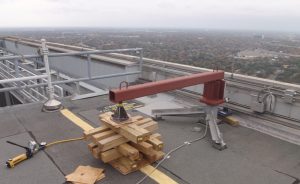
Some other important considerations regarding load testing of FASE include making sure the load is applied in the direction of actual use during service, does it provide a means to protect the roofing system and building structure from damage during testing (Figure 5), and has load testing been done for all FASE components? Load testing a sample of the fall arrest anchors, for example, does not provide any information regarding the remaining untested fall arrest anchors, regardless of whether those other anchors are the exact same type. The reason is that the building envelope components hide the connections of the anchors to the building structure. Some anchor connections to the building structure could have been installed in a deficient manner. They could be different due to the building frame configurations, or they could have been compromised due to corrosion from water infiltration, etc. Also, it is essential to have the means to accurately measure the load applied during testing and deflections of the FASE components (Figure 6).
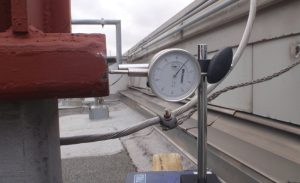
Case Study – Inadequate “Half-Load” Testing
A defective davit base at a high-rise building failed while in service supporting a powered platform with two hoists, each rated for 1,000 pounds. The subject davit base was load tested prior to the failure event by a “half-load” test. The minimum design load for davit bases per OSHA is 4 times the rated load of the hoist (1,000 pounds in this case) – i.e., 4,000 pounds. The load test previously performed was for 2,000 pounds which is half the minimum. The davit base was reportedly claimed to comply with applicable OSHA standards based on the 2,000 pounds load test.
So, what was the big deal? The davit base was load tested to only half the minimum required load; that does not mean it was unsafe. Well, in this case, it was. The issue was that a hoist on the powered platform stalled because it was caught on a ledge of one of the floors of the building. This means the hoist imposed a stall load on the davit base. That stall load was greater than 2,000 pounds. OSHA allows the stall load of hoists to be up to 3 times the rated load of the hoists. The davit base failed at a load greater than 2,000 pounds and less than the full factored load. The failure of the davit base led to one of the workers on the powered platform at the time falling and being seriously injured. If the davit base were tested to the full factored loads required by the IBC, the deficient davit base would have been identified during the load testing. Testing to full factored loads, in turn, would have likely prevented the tragedy of the injured worker.
Conclusions
The following are some key points for Structural Engineers regarding FASE requirements and load testing.
- Always test all FASE components to full factored loads to verify compliance with minimum required strengths.
- Perform the load test to simulate, as close as possible, the actual in-service conditions.
- If load testing is not physically possible, thorough inspection and structural analysis could be a way to verify the strength of FASE components. Also, proof load testing to loads beyond minimum factored loads could also be an option.
- Some OSHA requirements do not make much practical sense, so engineering judgment is required.■
References
International Code Council. International Building Code. Falls Church, VA: International Code Council, 2015
Title 29 of the Code of Federal Regulations
- a. “1910.66–Powered Platform for Building Maintenance.”
www.osha.gov/laws-regs/regulations/standardnumber/1910/1910.66 - b. “1926.451–General Requirements.”
www.osha.gov/laws-regs/regulations/standardnumber/1926/1926.451 - c. “1926.502–Fall Protection Systems Criteria and Practices.”
www.osha.gov/laws-regs/regulations/standardnumber/1926/1926.502 - d. “1910.27–Scaffolds and Rope Descent Systems (RDS).”
www.osha.gov/laws-regs/regulations/standardnumber/1910/1910.27 - e. “1910.30–Training Requirements.”
www.osha.gov/laws-regs/regulations/standardnumber/1910/1910.30
American Society of Civil Engineers. Facade Access Equipment: Structural Design, Evaluation, and Testing. Reston, VA.: American Society of Civil Engineers, 2015

